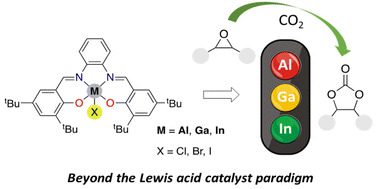Group 13 salphen compounds (In, Ga and Al): a comparison of their structural features and activities as catalysts for cyclic carbonate synthesis†
Abstract
Many complexes based on group 13 elements have been successfully applied as catalysts for the synthesis of cyclic carbonates from epoxides and CO2 and to date these have provided some of the most active catalysts developed. It is notable that most reports have focused on the use of aluminium-based compounds likely because of the well-established Lewis acidity of this element and its cost. In comparison, relatively little attention has been paid to the development of catalysts based on the heavier group 13 elements, despite their known Lewis acidic properties. This study describes the synthesis of aluminium, gallium and indium compounds supported by a readily prepared salphen ligand and explores both their comparative structures and also their potential as catalysts for the synthesis of cyclic carbonates. In addition, the halide ligand which forms a key part of the compound has been systematically varied and the effect of this change on the structure and catalytic activity is also discussed. It is demonstrated that the indium compounds are actually, and unexpectedly, the most active for cyclic carbonate synthesis, despite their lower Lewis acidity when compared to their aluminium congeners. The experimental observations from this work are fully supported by a Density Functional Theory (DFT) study, which provides important insights into the reasons as to why the indium catalyst with bromide, [InBr(salphen)], is most active.



 Please wait while we load your content...
Please wait while we load your content...